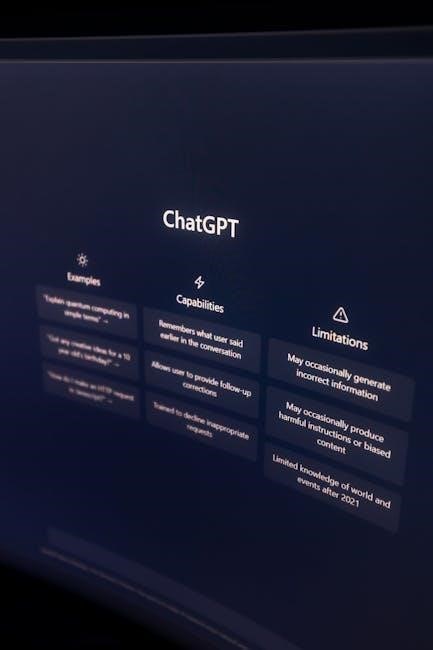IQ/OQ/PQ examples are crucial for validating medical device manufacturing processes, ensuring compliance and consistency. These qualifications are essential for installation, operational, and performance testing, with specific examples available in PDF templates.
Overview of IQ/OQ/PQ in Process Validation
IQ/OQ/PQ are critical phases in process validation, ensuring medical devices and equipment meet regulatory standards. IQ verifies proper installation, OQ tests operational consistency, and PQ confirms performance under real conditions. These steps ensure compliance, reliability, and safety in manufacturing processes. Proper documentation with templates like IQ/OQ/PQ PDF examples is essential for traceability and regulatory approval. Each phase builds on the previous, providing a comprehensive validation framework. These protocols are fundamental in maintaining quality assurance and adherence to global standards, ensuring products are consistently produced as intended.
Importance of IQ/OQ/PQ in Regulatory Compliance
Importance of IQ/OQ/PQ in Regulatory Compliance
IQ/OQ/PQ are essential for ensuring regulatory compliance in medical device manufacturing. These qualifications verify that equipment operates as intended, meeting FDA and GMP standards. Proper documentation, such as IQ/OQ/PQ PDF examples, demonstrates adherence to regulatory requirements. Compliance ensures product safety, quality, and reliability. Without these validations, manufacturers risk non-compliance, leading to audits, penalties, and potential market restrictions. IQ/OQ/PQ protocols provide a structured approach to validation, ensuring transparency and traceability. Regulatory bodies rely on these phases to confirm that manufacturing processes consistently produce high-quality products. Thus, IQ/OQ/PQ are critical for maintaining compliance and avoiding regulatory hurdles.

Definitions and Scope
IQ, OQ, and PQ are critical validation phases ensuring equipment installation, operation, and performance meet specifications. They define the scope of process validation, ensuring safety, quality, and consistency.
What is Installation Qualification (IQ)?
Installation Qualification (IQ) is the initial validation phase ensuring equipment is installed correctly. It verifies that all components, documentation, and pre-requisites meet specified requirements. IQ involves checking hardware, software, and configurations to ensure they align with design specifications and user requirements. This phase is critical for laying the foundation for subsequent validation steps, such as OQ and PQ. Proper IQ ensures that the equipment is ready for operational testing and performance evaluation, minimizing risks of non-compliance or operational failures. Detailed IQ checklists and templates are widely available, providing structured guidance for successful qualification.

What is Operational Qualification (OQ)?
Operational Qualification (OQ) is the second phase of validation, focusing on testing equipment under operational conditions. It verifies that the system functions as intended across its operational range, including worst-case scenarios. OQ involves testing at extreme temperatures, pressures, or other conditions to ensure reliability. This phase validates user requirements and ensures the equipment performs consistently under varying loads. OQ is conducted after IQ and before PQ, providing assurance that the system is ready for performance testing. Detailed protocols and templates guide the execution of OQ, ensuring compliance with regulatory standards and proper documentation of results.
What is Performance Qualification (PQ)?
Performance Qualification (PQ) is the final validation phase, ensuring equipment consistently performs according to specifications under routine conditions. It validates the system’s long-term reliability and performance across multiple production cycles. PQ tests include monitoring over time, simulating real-world usage, and verifying consistency. This phase confirms that the equipment meets all user requirements and regulatory standards. Detailed documentation, such as logs and test reports, is essential. PQ follows successful IQ and OQ, ensuring the system is ready for commercial production. Templates and examples in PDF format provide structured guidance for executing and recording PQ activities efficiently.

Differences Between IQ, OQ, and PQ
IQ, OQ, and PQ differ in scope and objectives. IQ verifies installation, OQ tests operational limits, and PQ ensures consistent performance over time, meeting user specifications.
IQ vs. OQ: Key Distinctions
IQ focuses on verifying the correct installation of equipment, ensuring all components are properly set up. In contrast, OQ tests the operational capabilities under normal and extreme conditions. While IQ ensures the system is installed as designed, OQ validates its functionality. IQ is static, checking documentation and setup, whereas OQ is dynamic, assessing performance. Both are essential for regulatory compliance but serve distinct purposes in the validation process. Understanding these differences is crucial for effective validation and ensuring equipment reliability.
OQ vs. PQ: Understanding the Variations
OQ and PQ are sequential phases in process validation, each serving distinct roles. OQ focuses on testing equipment under operational conditions, verifying its performance under both normal and extreme scenarios. It ensures the system functions as intended consistently. PQ, however, evaluates the equipment’s long-term performance, assessing its capability to maintain consistent results over time. While OQ is about operational consistency, PQ confirms reliability and repeatability across varied conditions. Together, they ensure compliance with regulatory standards, but their objectives and scopes differ significantly in the validation process.
IQ vs. PQ: Comparative Analysis
IQ and PQ are distinct phases in the validation process, each with unique objectives. IQ focuses on verifying the correct installation of equipment, ensuring all components are properly set up and meet specifications. In contrast, PQ evaluates the equipment’s long-term performance, assessing its ability to consistently produce desired results under routine conditions. While IQ is a foundational step ensuring the system is installed correctly, PQ confirms its reliability and performance over time. Both are critical for regulatory compliance, but IQ is static, focusing on installation, whereas PQ is dynamic, ensuring sustained performance across varying operational scenarios.

Examples of IQ/OQ/PQ in Practice

IQ/OQ/PQ examples include validating temperature control systems, manufacturing lines, and laboratory equipment. These processes ensure equipment operates as intended, meeting regulatory standards and production requirements effectively.
IQ Examples for Equipment Installation
IQ examples include verifying equipment installation parameters, such as power supply, connectivity, and software setup. For instance, ensuring a machine is correctly connected to a power source, all components are properly assembled, and documentation matches specifications. Another example is checking network configurations and calibrations to manufacturer guidelines. IQ also involves verifying that safety features, like emergency stops, are functional. These checks ensure equipment is installed correctly and ready for operational testing. Detailed examples and templates are available in PDF formats, guiding users through specific installation qualification processes for various devices and systems.
OQ Examples for Operational Testing
OQ examples involve testing equipment under operational conditions to ensure functionality. This includes verifying temperature ranges, cycle times, and pressure limits. For instance, an autoclave might undergo testing at maximum temperature and humidity. Another example is checking if a machine consistently produces uniform batches. OQ also tests alarm systems, ensuring they activate correctly during deviations. Examples include validating user interface controls and verifying data logging accuracy. These tests confirm that equipment performs as intended under varying conditions, preparing it for performance qualification. Detailed OQ examples and templates are available in PDF formats, offering structured approaches for operational testing.
PQ Examples for Performance Validation
PQ examples focus on validating equipment performance over time. This includes long-term testing under various conditions, such as repeated use or varying loads. For instance, a production line might undergo PQ to ensure consistent output across shifts. Another example is validating a sterilizer’s performance by testing multiple cycles with biological indicators. PQ also involves verifying that equipment maintains accuracy and precision over extended periods. Examples include monitoring temperature stability in cold storage units or assessing the durability of packaging machinery. Detailed PQ examples and templates in PDF formats provide guidelines for thorough performance validation, ensuring reliability and compliance with regulatory standards.
IQ/OQ/PQ Documentation and Templates
PQ examples demonstrate equipment performance under real-world conditions. Tests include long-term operation, varying loads, and repeated use. For instance, sterilizers are validated using biological indicators across multiple cycles. Cold storage units are tested for consistent temperature maintenance. Packaging machinery durability is assessed over extended periods. These examples ensure equipment reliability and compliance. Detailed PQ templates in PDF formats guide thorough validation processes, covering test protocols, data collection, and acceptance criteria to confirm performance consistency and adherence to regulatory standards.
Sample IQ/OQ/PQ Templates in PDF Format
Sample IQ/OQ/PQ templates in PDF format provide structured frameworks for validating equipment and processes. These templates cover installation, operational, and performance qualifications, ensuring compliance with regulatory standards. They include sections for pre-installation checks, testing procedures, and data collection. Many templates incorporate regulatory requirements and industry best practices, offering clear guidelines for each validation phase. For example, IQ templates detail equipment installation verification, while OQ templates focus on operational testing under various conditions. PQ templates emphasize performance consistency over time. These PDF templates are customizable, allowing users to tailor them to specific equipment or processes, ensuring thorough and documented validation outcomes. They are widely used in pharmaceutical, medical device, and biotech industries to maintain quality and compliance.
How to Prepare IQ/OQ/PQ Protocols
Preparing IQ/OQ/PQ protocols involves defining clear objectives, scopes, and acceptance criteria for each validation phase. Start with installation qualification (IQ) by verifying equipment installation per manufacturer specifications. Next, operational qualification (OQ) ensures the equipment operates as intended under various conditions. Finally, performance qualification (PQ) confirms consistent performance over time. Use sample templates in PDF format to streamline the process, ensuring compliance with regulatory standards. Include detailed test scripts, data collection forms, and approval sections; Collaborate with quality assurance to review and approve protocols, ensuring a robust validation process. Proper documentation is key for audit readiness and maintaining compliance.
Best Practices for Documenting Validation Phases
Documenting IQ/OQ/PQ phases requires clarity, consistency, and thoroughness. Use standardized templates to ensure uniformity across all records. Include detailed descriptions of test procedures, results, and deviations. Maintain traceability by linking each phase to equipment, processes, and acceptance criteria. Ensure all documents are reviewed, approved, and version-controlled to prevent unauthorized changes. Use clear and concise language, avoiding ambiguities. Incorporate visual aids like charts or graphs for better understanding. Regularly update records to reflect any changes or revalidations. Ensure electronic records are securely stored and accessible for audits. Refer to regulatory guidelines and industry standards to maintain compliance. Proper documentation is critical for audit preparedness and demonstrating process control.

Challenges in IQ/OQ/PQ Processes
Common challenges include ensuring compliance, managing complex documentation, and addressing equipment-specific requirements. Time constraints, resource allocation, and interpreting regulatory expectations also pose significant hurdles during validation phases.
Common Issues in IQ/OQ/PQ Execution
Common challenges during IQ/OQ/PQ execution include incomplete or inaccurate documentation, equipment malfunction, and deviations from established protocols. Ensuring compliance with regulatory standards while managing complex testing procedures can be difficult. Additionally, interpreting test results, addressing equipment-specific requirements, and maintaining consistent environmental conditions pose significant hurdles. Human error, such as improper calibration or data entry mistakes, can also lead to validation failures. Furthermore, resource allocation, time constraints, and coordination between teams often complicate the process. Addressing these issues requires meticulous planning, robust documentation, and adherence to best practices to ensure successful validation outcomes.
Troubleshooting Tips for Validation Phases
Troubleshooting during IQ/OQ/PQ involves identifying and resolving deviations promptly. Review protocols for clarity and ensure all steps are followed meticulously. Regularly calibrate equipment to prevent measurement errors. Document all issues and corrective actions taken. Conduct thorough risk assessments to address potential failures. Utilize checklists to ensure no step is overlooked. Train personnel to recognize and report anomalies. Collaborate with quality assurance teams to verify compliance. Implement automated tools where possible to minimize human error. Maintain detailed records for traceability and future reference. Addressing issues systematically ensures validation phases are completed efficiently and effectively, meeting regulatory standards and ensuring product quality.
Overcoming Regulatory Hurdles
Overcoming regulatory hurdles in IQ/OQ/PQ requires a thorough understanding of compliance requirements and proactive planning. Ensure all documentation aligns with global standards like FDA and GMP; Regularly update protocols to reflect changing regulations. Engage with regulatory authorities early to address potential issues. Utilize standardized templates, such as IQ/OQ/PQ examples in PDF format, to streamline processes and ensure consistency. Conduct gap analyses to identify and mitigate risks. Foster collaboration between quality assurance and operational teams to maintain compliance. By adopting a systematic approach, organizations can navigate regulatory challenges effectively, ensuring validation phases meet stringent requirements and gain approval.

Best Practices for Successful IQ/OQ/PQ
Adopt standardized protocols, utilize IQ/OQ/PQ templates, and ensure thorough documentation. Conduct regular audits and training to maintain compliance and consistency across all validation phases.
Planning and Execution Strategies
Effective IQ/OQ/PQ planning involves defining clear objectives, timelines, and resource allocation. Utilize detailed checklists and templates from PDF examples to ensure systematic execution. Assign responsibilities to trained personnel, conduct risk assessments, and integrate quality assurance reviews. Regularly monitor progress and document deviations for corrective actions. Leveraging digital tools enhances traceability and compliance. Cross-referencing with regulatory guidelines ensures alignment with global standards. Proactive communication among teams fosters a collaborative environment, driving successful validation outcomes.

Role of Quality Assurance in Validation
Quality Assurance (QA) plays a pivotal role in ensuring the integrity and compliance of IQ/OQ/PQ processes; QA oversees the development and execution of validation protocols, ensuring adherence to regulatory standards. By reviewing documentation, such as PDF templates, QA verifies that all testing phases meet predefined criteria. They conduct audits to identify deviations and ensure corrective actions are implemented. QA also provides training to personnel involved in validation, fostering a culture of compliance and quality. Their oversight guarantees that the equipment performs consistently, aligning with industry standards and regulatory requirements.
Continuous Improvement in Validation Processes
Continuous improvement in validation processes involves systematically reviewing and enhancing IQ/OQ/PQ activities. By analyzing feedback from each validation phase, teams identify inefficiencies and implement corrective actions. Regular audits and performance metrics help track progress, ensuring compliance with evolving regulatory standards. Leveraging digital tools and updated PDF templates streamlines documentation, reducing errors and improving traceability. Training programs and knowledge-sharing sessions also contribute to a culture of ongoing improvement, fostering expertise and adaptability within validation teams to meet future challenges effectively.

Future Trends in IQ/OQ/PQ
Future trends in IQ/OQ/PQ include advancements in automation, AI-driven validation tools, and global harmonization of standards, enhancing efficiency and compliance in process validation.
Advancements in Validation Techniques
Advancements in validation techniques are transforming IQ/OQ/PQ processes through digital solutions, such as automated data collection and real-time monitoring. These innovations enhance accuracy and reduce manual errors. Additionally, the integration of AI and machine learning enables predictive maintenance and continuous validation, streamlining compliance with regulatory standards. Cloud-based platforms also facilitate collaborative workflows and secure documentation storage. These advancements not only improve operational efficiency but also ensure that validation protocols remain robust and up-to-date, meeting the evolving demands of the pharmaceutical and medical device industries.
Impact of Digitalization on IQ/OQ/PQ
Digitalization is revolutionizing IQ/OQ/PQ processes by enhancing efficiency and compliance. Cloud-based platforms enable real-time data collection and automated reporting, reducing manual errors. AI-driven tools improve predictive analytics for equipment performance. Digital documentation and e-signatures streamline validation workflows, ensuring traceability. These advancements facilitate faster approval processes and reduce operational costs. Additionally, digital solutions promote consistency across global teams, aligning with regulatory requirements. The integration of digital technologies ensures that IQ/OQ/PQ processes remain agile and adaptable to industry changes, driving innovation in validation practices.
Global Harmonization of Validation Standards
Global harmonization of validation standards ensures consistency across regions, facilitating compliance with international regulations. Organizations like the FDA and EMA align their guidelines, reducing redundancy in IQ/OQ/PQ processes. Standardized protocols enable seamless integration of validation practices worldwide, while localized requirements are respected. This harmonization simplifies cross-border approvals and enhances collaboration among global teams. It also promotes the use of universal templates, such as IQ/OQ/PQ examples in PDF formats, ensuring uniformity in documentation. As a result, companies can operate more efficiently in diverse markets, maintaining high-quality standards and reducing compliance burdens.